Abstract
The synthetic disaccharide 3-O-α-tyvelopyranosyl-α-D-mannopyranoside, identical to the O antigen 9 determinant in Salmonella, covalently linked to bovine serum albumin and suspended in Freund complete adjuvant, was used as an immunogen in mice. Antibodies in high titer were formed against the O9 determinant as estimated by a bactericidal assay, whereas only low titers of hemagglutinating antibodies were found. A sensitive in vivo assay demonstrated that in immunized mice, after challenge with two strains of equal virulence but with different O antigens (O9, 12 and O4, 5, 12, respectively), the growth of the strain with the O9 determinant was suppressed in comparison to that with the O4 determinant.
Full text
PDF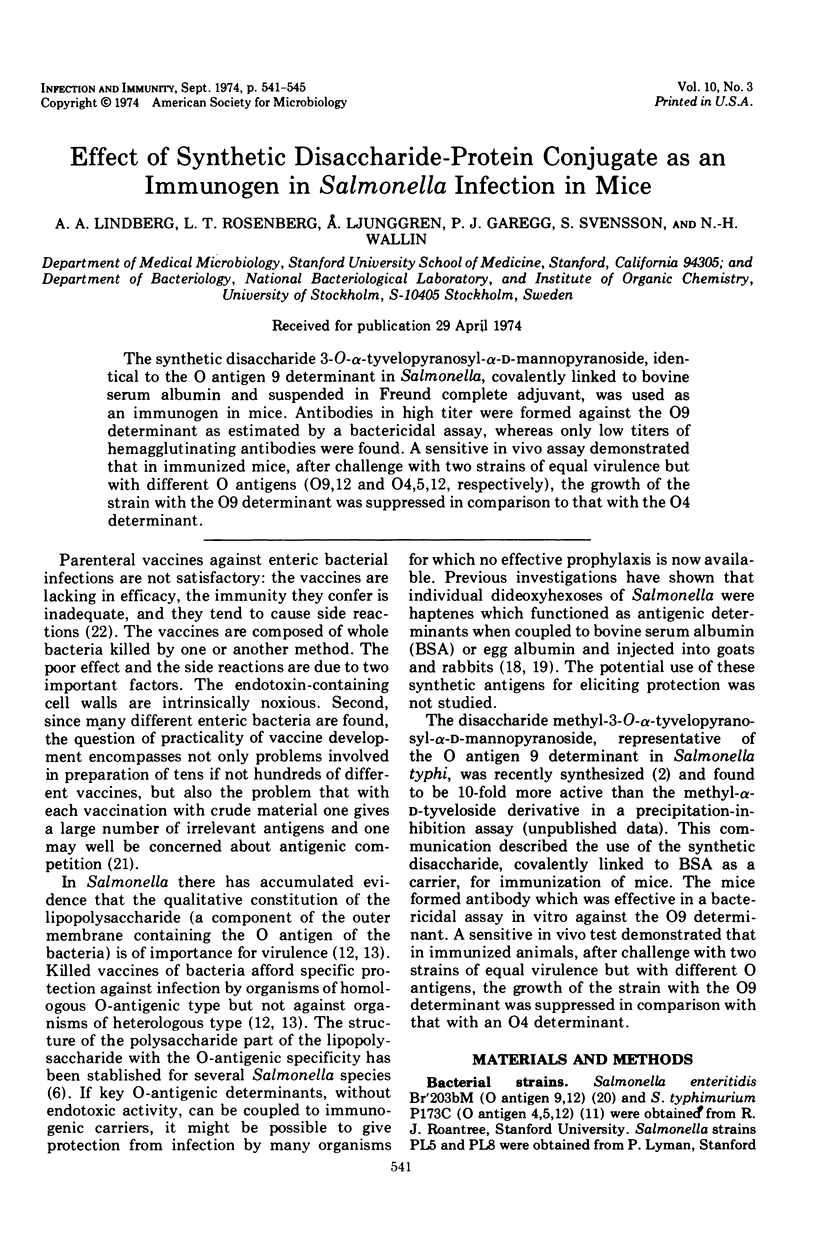
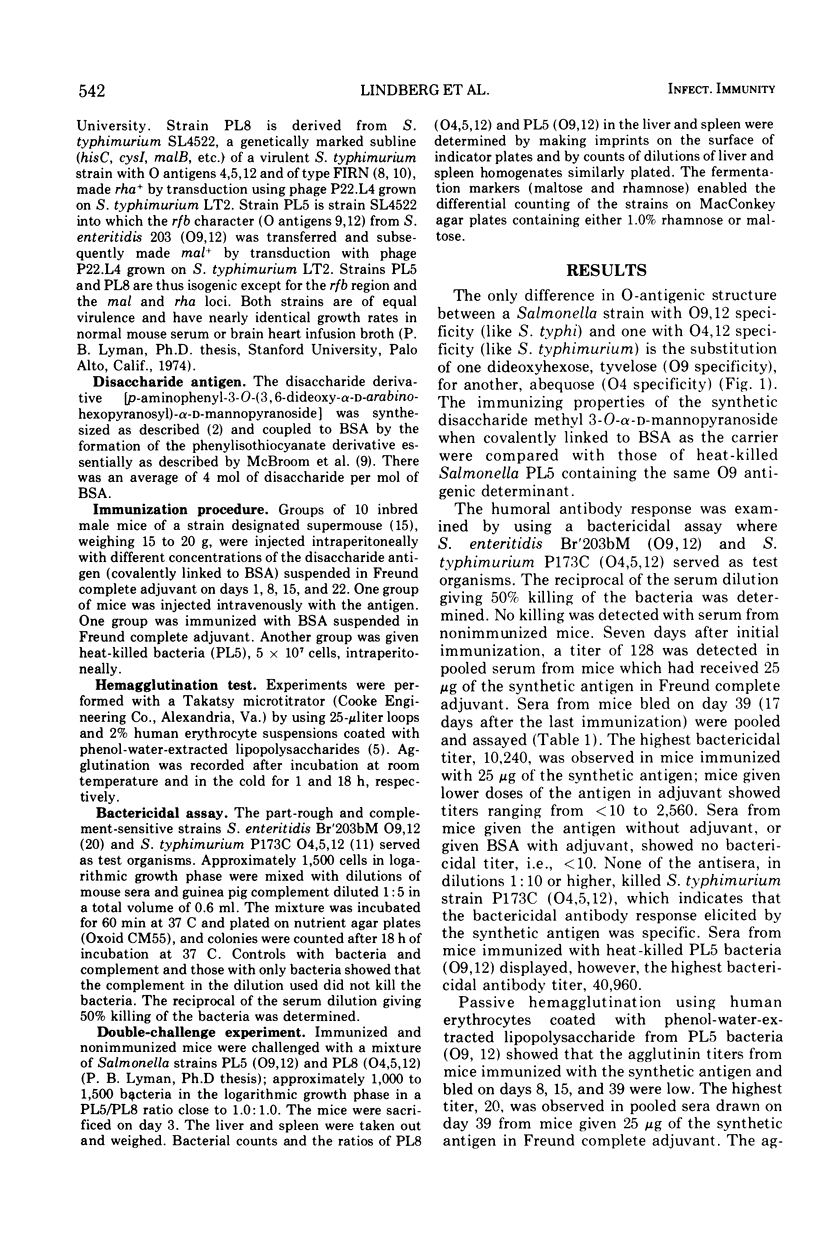
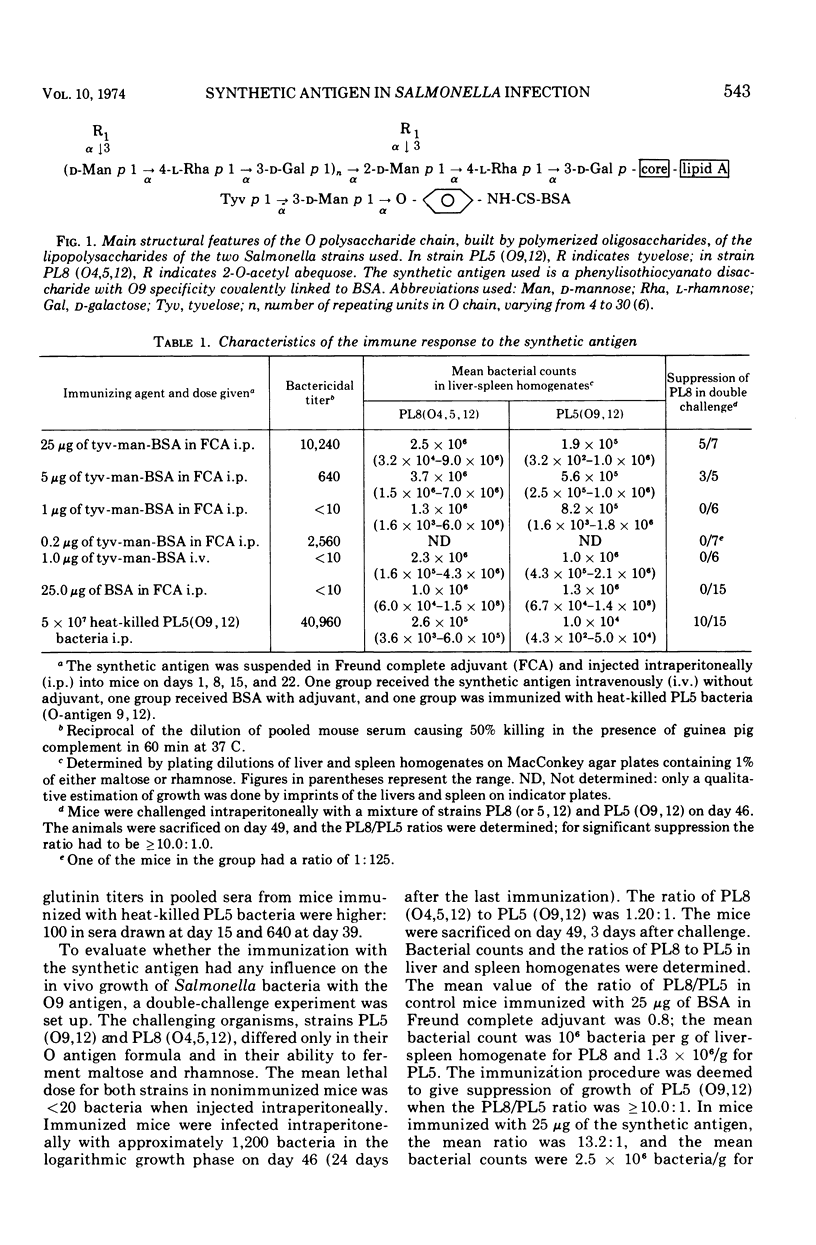
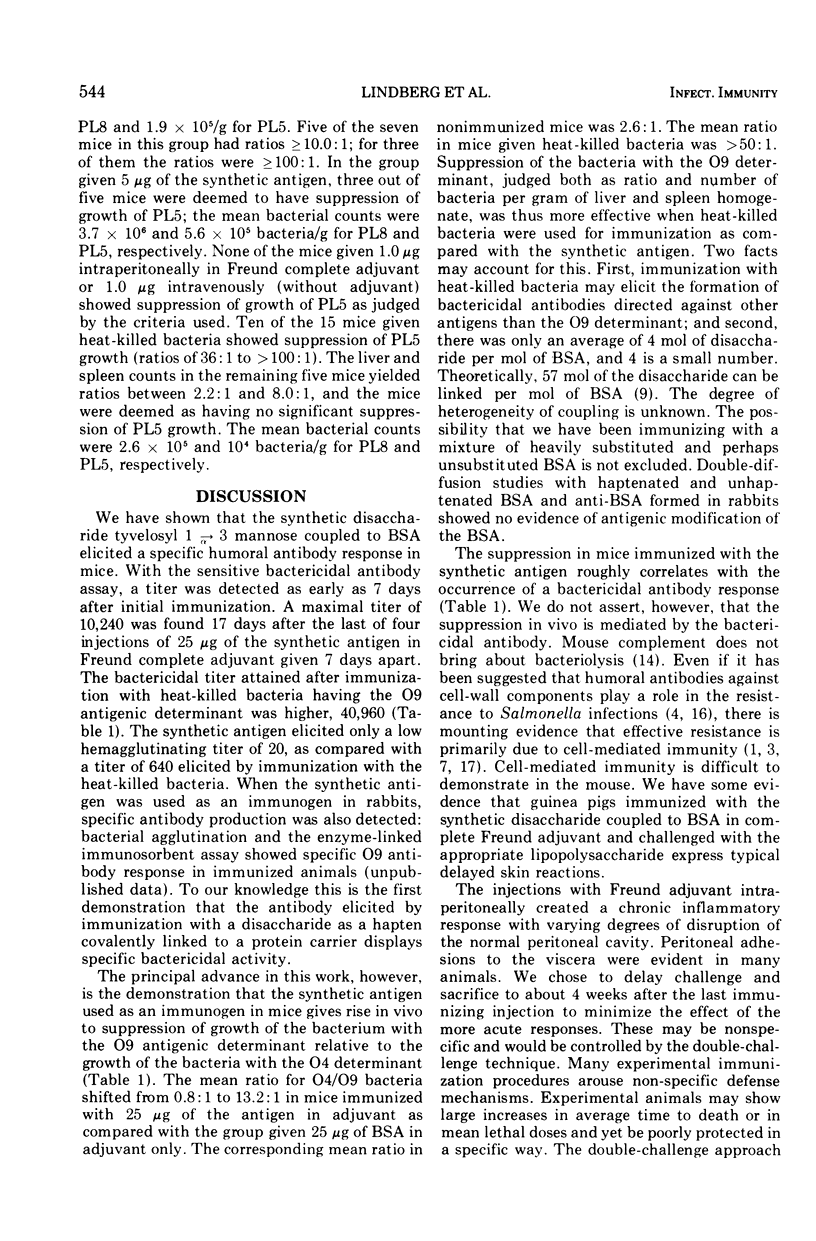
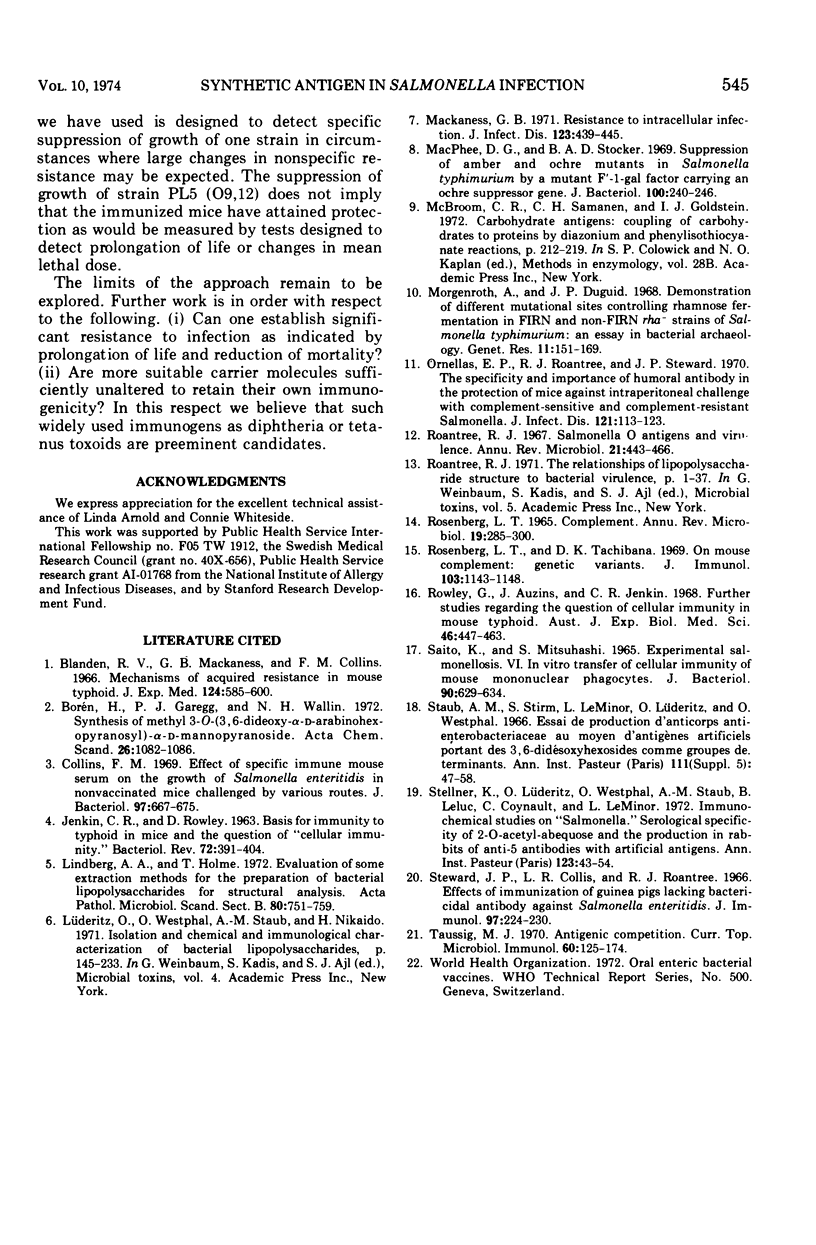
Selected References
These references are in PubMed. This may not be the complete list of references from this article.
- Blanden R. V., Mackaness G. B., Collins F. M. Mechanisms of acquired resistance in mouse typhoid. J Exp Med. 1966 Oct 1;124(4):585–600. doi: 10.1084/jem.124.4.585. [DOI] [PMC free article] [PubMed] [Google Scholar]
- Borén H. B., Garegg P. J., Wallin N. H. Synthesis of methyl 3-0-(3,6-dideoxy- -D-arabino-hexopyranosyl)- -D-mannopyranoside. Acta Chem Scand. 1972;26(3):1082–1086. doi: 10.3891/acta.chem.scand.26-1082. [DOI] [PubMed] [Google Scholar]
- Collins F. M. Effect of specific immune mouse serum on the growth of Salmonella enteritidis in nonvaccinated mice challenged by various routes. J Bacteriol. 1969 Feb;97(2):667–675. doi: 10.1128/jb.97.2.667-675.1969. [DOI] [PMC free article] [PubMed] [Google Scholar]
- JENKIN C. R., ROWLEY D. BASIS FOR IMMUNITY TO TYPHOID IN MICE AND THE QUESTION OF "CELLULAR IMMUNITY". Bacteriol Rev. 1963 Dec;27:391–404. doi: 10.1128/br.27.4.391-404.1963. [DOI] [PMC free article] [PubMed] [Google Scholar]
- Lindberg A. A., Holme T. Evaluation of some extraction methods for the preparation of bacterial lipopolysaccharides for structural analysis. Acta Pathol Microbiol Scand B Microbiol Immunol. 1972;80(5):751–759. doi: 10.1111/j.1699-0463.1972.tb00203.x. [DOI] [PubMed] [Google Scholar]
- MacPhee D. G., Stocker B. A. Suppression of amber and ochre mutants in Salmonella typhimurium by a mutant F'-1-gal factor carrying an ochre suppressor gene. J Bacteriol. 1969 Oct;100(1):240–246. doi: 10.1128/jb.100.1.240-246.1969. [DOI] [PMC free article] [PubMed] [Google Scholar]
- Mackaness G. B. Resistance to intracellular infection. J Infect Dis. 1971 Apr;123(4):439–445. doi: 10.1093/infdis/123.4.439. [DOI] [PubMed] [Google Scholar]
- Morgenroth A., Duguid J. P. Demonstration of different mutational sites controlling rhamnose fermentation in FIRN and non-FIRN rha-strains of Salmonella typhimurium: an essay in bacterial archaeology. Genet Res. 1968 Apr;11(2):151–169. doi: 10.1017/s0016672300011320. [DOI] [PubMed] [Google Scholar]
- Ornellas E. P., Roantree R. J., Steward J. P. The specificity and importance of humoral antibody in the protection of mice against intraperitoneal challenge with complement-sensitive and complement-resistant Salmonella. J Infect Dis. 1970 Feb;121(2):113–123. doi: 10.1093/infdis/121.2.113. [DOI] [PubMed] [Google Scholar]
- Roantree R. J. Salmonella O antigens and virulence. Annu Rev Microbiol. 1967;21:443–466. doi: 10.1146/annurev.mi.21.100167.002303. [DOI] [PubMed] [Google Scholar]
- Rosenberg L. T. "Complement". Annu Rev Microbiol. 1965;19:285–300. doi: 10.1146/annurev.mi.19.100165.001441. [DOI] [PubMed] [Google Scholar]
- Rosenberg L. T., Tachibana D. K. On mouse complement: genetic variants. J Immunol. 1969 Nov;103(5):1143–1148. [PubMed] [Google Scholar]
- Rowley D., Auzins I., Jenkin C. R. Further studies regarding the question of cellular immunity in mouse typhoid. Aust J Exp Biol Med Sci. 1968 Aug;46(4):447–463. doi: 10.1038/icb.1968.38. [DOI] [PubMed] [Google Scholar]
- Saito K., Mitsuhashi S. Experimental Salmonellosis VI. In Vitro Transfer of Cellular Immunity of Mouse Mononuclear Phagocytes. J Bacteriol. 1965 Sep;90(3):629–634. doi: 10.1128/jb.90.3.629-634.1965. [DOI] [PMC free article] [PubMed] [Google Scholar]
- Staub A. M., Stirm S., Le Minor I., Luderitz O., Westphal O. Essai de production d'anticorps anti-Enterobacteriaceae au moyen d'antigènes artificiels portant des 3,6-didésoxyhexosides comme groupes déterminants. Ann Inst Pasteur (Paris) 1966 Nov;111(5 Suppl):47–58. [PubMed] [Google Scholar]
- Stellner K., Lüderitz O., Westphal O., Staub A. M., Leluc B., Coynault C., Le Minor L. Immunochemical studies on "Salmonella". Serological specificity of 2-O-acetylabequose and the production in rabbits of anti-5 antibodies with artificial antigens. Ann Inst Pasteur (Paris) 1972 Jul;123(1):43–54. [PubMed] [Google Scholar]
- Steward J. P., Collis L. R., Roantree R. J. Effects of immunization of guinea pigs lacking bactericidal antibody against Salmonella enteritidis. J Immunol. 1966 Aug;97(2):224–230. [PubMed] [Google Scholar]
- Taussig M. J. Antigenic competition. Curr Top Microbiol Immunol. 1973;60:125–174. doi: 10.1007/978-3-642-65502-9_4. [DOI] [PubMed] [Google Scholar]


